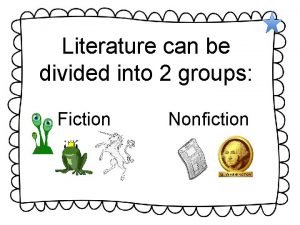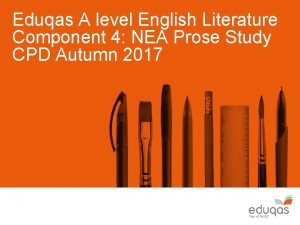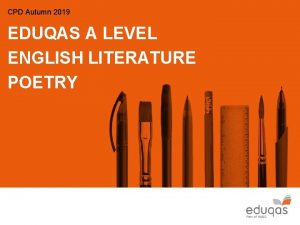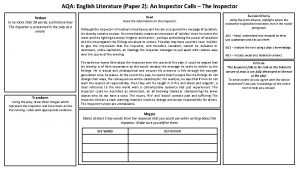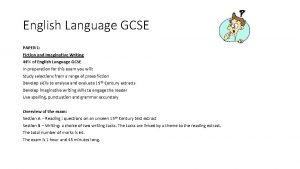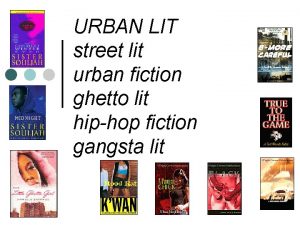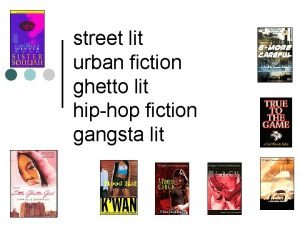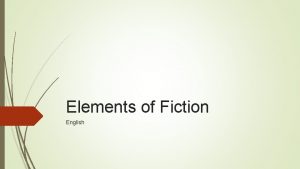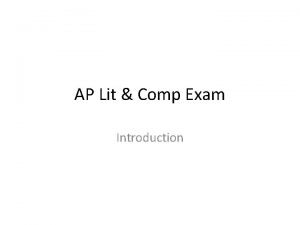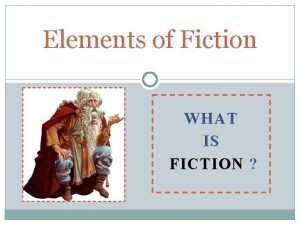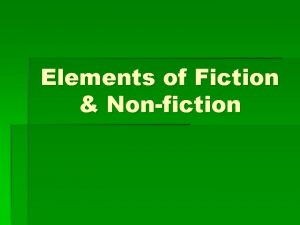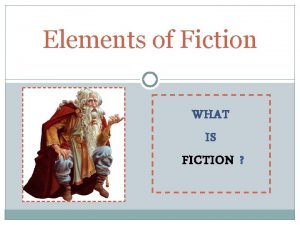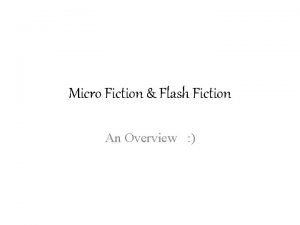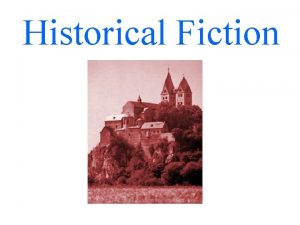The Art of Fiction AP English Lit Comp















- Slides: 15

The Art of Fiction AP English Lit. & Comp.

Fiction • The word fiction refers to an imaginative creation, invention, or pretense. • In literature, fiction describes any short or long prose story that originates from the creative imagination of the author rather than from historical fact. • Although fiction might include historical detail, its main purpose is to tell a story that in some way mirrors life.

History of Fiction • Ancient civilizations had oral traditions through which they passed on stories about life and living. ▫ These ancient legends were often religious in theme; they interwove tales of gods such as Zeus and Athena with famous or important people such as Oedipus, Helen of Troy, or Hercules. • Ancient civilizations also recorded their stories in writing. ▫ Egyptian papyri tell stories about life more than six thousand years ago. ▫ Greek and Roman writers recorded ancient oral epic tales such as The Odyssey and The Iliad. ▫ The Bible can also be viewed as a written collection of ancient fables, parables, war stories, adventures, and romances. • Fiction in the modern sense wasn’t fully established until the seventeenth and eighteenth centuries.

Types of Fiction • The two types of fiction are the novel and the short story. The major difference between the two is obvious – length. • The share the same basic elements: ▫ Premise ▫ Plot ▫ Charactacters

Premise • The ground rules for a work of fiction to follow, dictating how the story will unfold. ▫ Some stories are meant to resemble reality ▫ Others are unrealistic and don’t reflect the world • Examples: ▫ Romance – two people meet and overcome an obstacle on their way to falling in love. ▫ Bildungsroman – a story about the personal development or maturing of a single character. ▫ Picaresque – the main character continually moves from adventure to adventure. ▫ Comedic – human difficulties can be treated with humor.

Conflict • The premise often contains the story’s main conflict. All stories concern some sort of conflict – it is what sparks growth, action, or movement. • The main conflict of the story may come up: ▫ When a character is presented with a change from daily routine that forces him into a new experience ▫ When two or more characters are in opposition to one another ▫ When characters are confronted with a natural force or even a new idea.

Plot • The plot is the story’s plan – the series of incidents, the chain of events, that follow from the stories premise. • The plot usually follows a cause and effect arrangement. • Leads inevitably through rising action to an ultimate climax (outcome of the conflict). • After the climax we have the denouement (French for untangling of a knot).

Plot Techniques • Exposition – gives the reader additional information about characters or events. Often at the beginning of the story, but can take place in other parts as well. ▫ Foreshadowing- signaling the outcome of the action in advance. ▫ Flashback – describing something that happened before as a way of explaining or setting up the plot.

Characters • No plot can progress without characters. • Types of characters in fiction are similar to the types of characters in drama – refer to the previous lecture for discussion of: ▫ ▫ Protagonist Antagonist Flat, Static Round, Dynamic

Point of View • Who is telling the story? The answer to that question determines the point of view. • To determine point of view, we have to consider two things: ▫ The amount of knowledge the voice of the story possesses. ▫ The role of the voice in the action of the story.

Point of View • Omniscient – a voice with the ability to know everything about events in the story or about most or all of the characters, including thoughts and feelings. (All-knowing) ▫ Allows the reader to interpret the plot or conflict through the perspective of all the characters. • Limited – only one point of view, rather than revealing all the characters. ▫ Reader gets to know only one character and see from their eyes. Makes the story more personal and intimate.

Point of View • First Person – when the protagonist tells his or her own story. Characterized by the use of the pronoun I. ▫ First person characters are directly involved with the action or directly observe the action, and their knowledge is limited to their own thoughts, feelings, and experiences. • Third Person – the voice of a narrator or character who is distant or removed from the action of the story. Characterized by the use of the pronouns he, she, they, or them. ▫ The voice can have either omniscient or limited knowledge of characters and events. May be used to show readers how characters and events are perceived by outsiders.

Point of View Challenges • Although you may be inclined to trust a character’s narration, you should always remember that this sort of story is filtered through only one character’s point of view. • If the character is untrustworthy, or refuses to believe something is true, you must at some point come to understand that the character is an unreliable narrator. • Always evaluate what fictional characters tell you, just as you do with people in real life, because what they say is affected by their limitations, attitudes, opinions, and personality.

Other • A more rare, but still important, point of view is the dramatic, or objective, point of view in which the narration is confined to the reporting of actions and speeches, with no commentary and no revelation of any of the characters’ thoughts. • The effect of this narration is the same as the effect of the camera in film—it records, but doesn’t comment.

• Fiction also contains other elements that we have studied before: ▫ Theme – the main or central idea ▫ Setting – environment and time in which a story takes place. ▫ Tone – reveals the attitude that the author has toward the subject. ▫ Irony – contrast or disparity between the expected and the actual. ▫ Symbolism – words, ideas, or objects that stand for other ideas.
 Is a genre of speculative fiction
Is a genre of speculative fiction What are nonfiction elements
What are nonfiction elements Contemporary realistic fiction vs historical fiction
Contemporary realistic fiction vs historical fiction Fiction and non fiction activities
Fiction and non fiction activities Are english language and literature separate gcses
Are english language and literature separate gcses Nea english literature a level
Nea english literature a level Igcse edexcel english literature past papers
Igcse edexcel english literature past papers Eduqas a level literature
Eduqas a level literature What paper is inspector calls on
What paper is inspector calls on Paper 1 fiction and imaginative writing
Paper 1 fiction and imaginative writing Hát kết hợp bộ gõ cơ thể
Hát kết hợp bộ gõ cơ thể Slidetodoc
Slidetodoc Bổ thể
Bổ thể Tỉ lệ cơ thể trẻ em
Tỉ lệ cơ thể trẻ em Chó sói
Chó sói Tư thế worm breton
Tư thế worm breton



